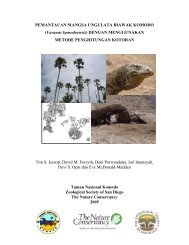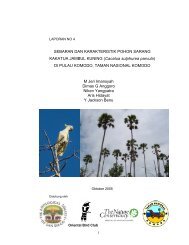Sustainable Financing of MPAs - Komodo National Park
Sustainable Financing of MPAs - Komodo National Park
Sustainable Financing of MPAs - Komodo National Park
You also want an ePaper? Increase the reach of your titles
YUMPU automatically turns print PDFs into web optimized ePapers that Google loves.
1.3.2 <strong>National</strong> level<br />
At the national level the government influences the possibility <strong>of</strong> the diverse finance<br />
mechanisms by economic incentives and existing law and regulation. The main national<br />
financing sources are the following:<br />
• Government bonds and taxes. Government's power to impose taxes can be used in a<br />
variety <strong>of</strong> ways to raise funds for conservation and to promote conservation activities<br />
in general. Besides relying on general tax revenues to fund conservation, some<br />
governments have raised revenues for conservation by imposing earmarked taxes or<br />
selling interest-bearing government bonds 5 (Quintela et al. 2004). Other taxes and fees<br />
are airport passenger fees and cruise ship passenger fees, hotel taxes and fines (Spergel<br />
and Moye 2004).<br />
• Real estate tax surcharges. The coast is <strong>of</strong>ten much more expensive than land<br />
elsewhere and is <strong>of</strong>ten owned by wealthy individuals or tourism-related businesses.<br />
Consequently, adding even a small fraction <strong>of</strong> 1 percent to existing real estate taxes has<br />
the potential to generate large amounts <strong>of</strong> money for biodiversity conservation and/or<br />
the acquisition <strong>of</strong> remaining open spaces to protect them from development. (Spergel<br />
and Moye 2004)<br />
• Special governmental projects. Governmental agencies can set up special projects that<br />
generate money for conservation such as funding <strong>of</strong> earmarked projects; competitive<br />
grants, lotteries, stamps etc. (Spergel and Moye 2004)<br />
• Private sector investments. Business planning, venture capital investments, concession<br />
arrangements, private sector management <strong>of</strong> protected areas and voluntary<br />
contributions are examples <strong>of</strong> private sector investments. Private investments are<br />
generally a relatively minor source <strong>of</strong> funding for parks and conservation. Developing<br />
countries generally provide few or no tax incentives for making charitable donations.<br />
There exist also for-pr<strong>of</strong>it investments providing financial returns for investors while<br />
promoting conservation in a designated environmental zone (Green Funds). (Spergel<br />
and Moye 2004)<br />
• Fishing industry revenue. Governments can raise revenues to manage fisheries by<br />
charging fishing payments, license fees, excise taxes and fines. They can charge levies<br />
on the commercial fishing industry and ask for fishing access payments. The protection<br />
<strong>of</strong> biodiversity contributes also to fish populations and fishing industry benefits from<br />
this spill-over effect. (Spergel and Moye 2004)<br />
1.3.3 Local level<br />
This income is generated at the site level by local business development in order to cover<br />
all costs related to the management <strong>of</strong> conservation activities, and with flexibility to amend<br />
them based on impacts and needs. The most common local level revenues come from the<br />
following sources:<br />
5 These can either be general obligation bonds, which are repaid out <strong>of</strong> the government’s future tax revenues; or special revenue bonds, which<br />
will be repaid out <strong>of</strong> charges and revenues generated by the specific project that is being financed; or bonds that are a hybrid <strong>of</strong> these two<br />
types. U.S. private investors are willing to buy these bonds, which <strong>of</strong>fer lower than current market rates <strong>of</strong> interest, because the interest earned<br />
is exempt from U.S. taxes. (Quintela et al. 2004)<br />
8






